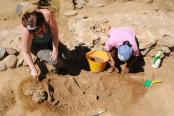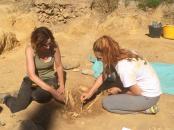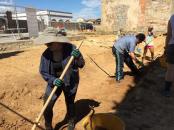CAMPAGNA 2015 |
1° SETTIMANA |
2° SETTIMANA |
3° SETTIMANA |
4° SETTIMANA |
5° SETTIMANA |
6° SETTIMANA |
25 GIUGNO 2015 
Resoconto della giornata di scavo
Area 2000
L’indagine prosegue intensiva su tutta la porzione centrale dell’allargamento Ovest con ottimi risultati. Sono stati completamente messi in luce e rimossi tre dei cinque scheletri individuati durante gli scorsi giorni: Usk 2516 è collocato nell’angolo sudorientale con orientamento Sud Nord e presenta una medaglietta bronzea posta sul bacino; Usk 2518 è posto più a nord, con orientamento opposto, e presenta gli arti inferiori incrociati e sovrapposti, elemento che fa presupporre la presenza di un sudario che ne ha determinato la posizione costretta; Usk 2520, orientato Nord Sud, è stato disturbato quasi completamente fatta eccezione per il femore destro ancora in connessione anatomica con il bacino; Usk 2519 (in US-2522) è orientato Nord Sud e deposto in decubito prono e collocato più ad Ovest. Quest’ultimo è stato esposto e documentato in due momenti differenti a causa della difficile lettura stratigrafica causata dalla presenza dei numerosi tagli sepolcrali che si intercettano l’uno con l’altro. Inizialmente, come detto ieri, risultava evidente solamente l’arto inferiore sinistro (femore e tibia), mentre in seguito, è stata appurata la presenza anche dell’arto inferiore destro in connessione con il bacino, il quale sarà documentato entro la giornata di domani.
La rimozione di Usk 2520, e di parte del riempimento (US 2523) inerente la fossa sepolcrale US-2522, ha permesso di identificare al di sotto un’ulteriore sepoltura dedicata ad un infante, malamente conservato, che sarà documentato, per ovvie ragioni stratigrafiche, solo dopo lo scavo completo di Usk 2519.
We started today’s excavation by cleaning and wetting the excavation area with water to better estimate any burial cuts. It seemed clear that the burials overlapped, some burials cutting others creating a complex stratigraphic profile. We took pictures of the site at this time. After this, we continued to excavate, further exposing USk 2521, 2518, and some human bones associated with fill. The stratigraphic context sheets were completed for two fills, US 2517 and 2525, and two cuts, -2515 and -2526. These cuts and fills were associated with skeletons USk 2516 and 2518, respectively. While this was being done, USk 2518 was removed and appropriately bagged. Meanwhile, excavation exposed an articulated, partially-complete right foot associated with 2521.
Also exposed today were two crania and one mandible, all located close together to the west of the previously exposed skeletons. At the end of the day, we found what may be the right lower appendicular portion of the prone skeleton, USk 2519, but more excavation is required tomorrow to verify this hypothesis. Another interesting skeletal feature found at the end of the excavation period was the outline of a crania, mandible, and possible rib of a young infant. We will explore this skeleton more tomorrow, but we anticipate that the bones will come out in poor condition. With further excavation in the following days, we plan to clarify the relationships between these burials and expose and remove the infant remains.
Area 3000
Nella porzione sud-orientale del Settore B è stata completata la messa in luce dell’inumato USK 3545, orientato W-E e deposto supino all’interno di US – 3531. Dopo essere stato fotografato ed accuratamente documentato, lo scheletro è stato rimosso, permettendo così la messa in evidenza dei margini della fossa sepolcrale, intercettata e tagliata nella porzione orientale, da un’altra tomba di epoca successiva. Più ad ovest si è inoltre proceduto con l’esposizione dell’individuo USK 3543, anch’esso supino ed orientato W-E. Si tratta verosimilmente di una donna di età matura, deposta originariamente all’interno di una cassa lignea, come sembrano suggerire la dislocazione della mandibola, l’apertura a ventaglio del torace e del bacino e la generale lassità articolare. Il corpo si presenta complessivamente in cattivo stato di conservazione e di esso rimane solamente la porzione superiore, mentre gli arti inferiori sono stati intercettati ed asportati da un’altra sepoltura. Molto interessante e suggestiva è la posizione delle braccia, simmetriche ed entrambe flesse sul torace e delle mani, verosimilmente giunte al livello del collo, forse in atteggiamento di preghiera. L’individuo presenta inoltre alcune patologie, come la frattura scomposta e saldata della scapola destra, lipping visibile soprattutto sulle vertebre lombari e tracce di periostite all’interno del coxale destro. Nella porzione nord-orientale è iniziata l’indagine della fossa sepolcrale US – 3541,all’interno della quale è in corso di scavo l’inumato USK 3546, orientato W-E e deposto in decubito dorsale.
Today in our area we uncovered the upper half of the skeleton that we have been working on in the south west, and got to the point of being able to finish excavating it tomorrow. In the south east section we filled out context sheets for our partial skeleton and completed the excavation by removing all the bones, wrapping them up in tissue, and labeling them. We then recorded the fill and the cut on individual context sheets. In the northern half of Area 3000/B, we continued to excavate the grave. The primary individual discovered has a mostly complete skeletal remains while the second set of remains appear to be a reduction. Currently we hypothesize the second remains are caused by a set of remains falling into the primary grave during decomposition. Tomorrow we will continue to excavate the individual and attempt the process of removal.
Area 5000
Oggi è stato scavato il taglio circolare in cui era immerso US 5068, uno dei grandi conci posti nel centro dell'area. La buca era riempita con del sedimento limo argilloso e ghiaia, mentre sul fondo erano presenti degli elementi litici di piccole dimensioni che fungevano da preparazione per la messa in opera del grande concio lavorato. Nonostante non si abbiano informazioni certe sulla funzione di questo elemento, possiamo supporre che si trattasse di un basamento per il sostegno di un palo in legno. Infine abbiamo ripulito l'area così da documentare e georeferenziare le ultime evidenze stratigrafiche emerse.
The excavation of Area 5000 began today with the preparation of the site for GIS mapping. This consisted of properly delineating the eastern parallel wall feature, defining the edges of the dark soil strip, and cleaning the trench. We also began to excavate a large stone which we believed to match another stone to the south. Upon excavation of the stone we learned that it does not match the second large stone, rather it extended roughly 15cm - 20cm down, at this point the stone was not removed. The second stone had been exposed from the previous excavation season and was removed today to better determine if this stone was used in the original construction of the Church. Both of these stones were photographed in context. When the stone was lifted a soil sample was taken from the strata under the stone. In conclusion the area was dampened and GIS points were taken.
Area 6000
Con la giornata odierna è stata quasi ultimata la messa in luce della trincea US -9007 mediante la rimozione del riempimento US 9002. L'esposizione delle pareti di questo grande taglio (orientato est-ovest) sta già permettendo di identificare diverse situazioni sepolcrali all'interno dei contesti tagliati (US 9001 ed US 9003); ciò confermerebbe l'ipotesi che vede l'area del sagrato adibita a sepolcreto.











